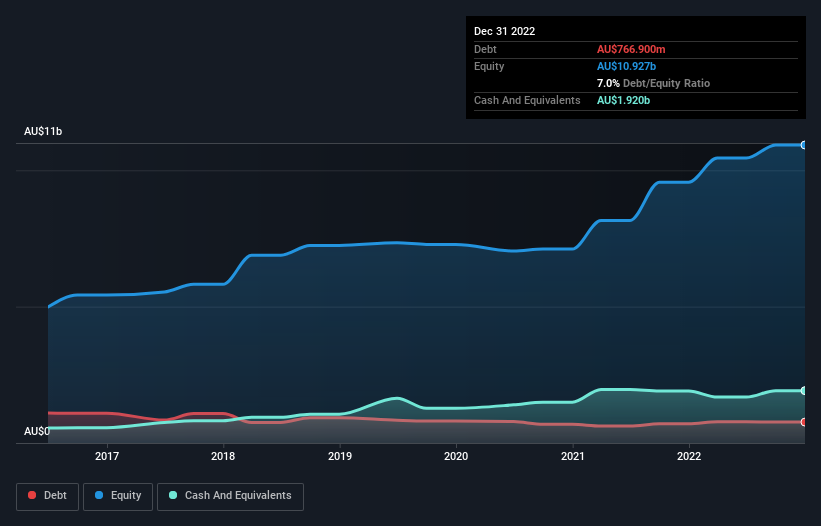
Some say volatility, rather than debt, is the best way to think about risk as an investor, but Warren Buffett famously said that 'Volatility is far from synonymous with risk.' So it might be obvious that you need to consider debt, when you think about how risky any given stock is, because too much debt can sink a company. Importantly, BlueScope Steel Limited (ASX:BSL) does carry debt. But should shareholders be worried about its use of debt?
When Is Debt A Problem?
Generally speaking, debt only becomes a real problem when a company can't easily pay it off, either by raising capital or with its own cash flow. Part and parcel of capitalism is the process of 'creative destruction' where failed businesses are mercilessly liquidated by their bankers. While that is not too common, we often do see indebted companies permanently diluting shareholders because lenders force them to raise capital at a distressed price. Of course, debt can be an important tool in businesses, particularly capital heavy businesses. The first thing to do when considering how much debt a business uses is to look at its cash and debt together.
View our latest analysis for BlueScope Steel
What Is BlueScope Steel's Debt?
You can click the graphic below for the historical numbers, but it shows that as of December 2022 BlueScope Steel had AU$766.9m of debt, an increase on AU$705.0m, over one year. But on the other hand it also has AU$1.92b in cash, leading to a AU$1.15b net cash position.

How Strong Is BlueScope Steel's Balance Sheet?
The latest balance sheet data shows that BlueScope Steel had liabilities of AU$3.50b due within a year, and liabilities of AU$1.49b falling due after that. Offsetting this, it had AU$1.92b in cash and AU$1.56b in receivables that were due within 12 months. So it has liabilities totalling AU$1.51b more than its cash and near-term receivables, combined.
Of course, BlueScope Steel has a market capitalization of AU$8.92b, so these liabilities are probably manageable. Having said that, it's clear that we should continue to monitor its balance sheet, lest it change for the worse. Despite its noteworthy liabilities, BlueScope Steel boasts net cash, so it's fair to say it does not have a heavy debt load!
It is just as well that BlueScope Steel's load is not too heavy, because its EBIT was down 31% over the last year. When a company sees its earnings tank, it can sometimes find its relationships with its lenders turn sour. When analysing debt levels, the balance sheet is the obvious place to start. But ultimately the future profitability of the business will decide if BlueScope Steel can strengthen its balance sheet over time. So if you're focused on the future you can check out this free report showing analyst profit forecasts.
Finally, a company can only pay off debt with cold hard cash, not accounting profits. BlueScope Steel may have net cash on the balance sheet, but it is still interesting to look at how well the business converts its earnings before interest and tax (EBIT) to free cash flow, because that will influence both its need for, and its capacity to manage debt. Over the most recent three years, BlueScope Steel recorded free cash flow worth 56% of its EBIT, which is around normal, given free cash flow excludes interest and tax. This free cash flow puts the company in a good position to pay down debt, when appropriate.
Summing Up
Although BlueScope Steel's balance sheet isn't particularly strong, due to the total liabilities, it is clearly positive to see that it has net cash of AU$1.15b. So we are not troubled with BlueScope Steel's debt use. The balance sheet is clearly the area to focus on when you are analysing debt. But ultimately, every company can contain risks that exist outside of the balance sheet. These risks can be hard to spot. Every company has them, and we've spotted 2 warning signs for BlueScope Steel (of which 1 is significant!) you should know about.
At the end of the day, it's often better to focus on companies that are free from net debt. You can access our special list of such companies (all with a track record of profit growth). It's free.
Valuation is complex, but we're here to simplify it.
Discover if BlueScope Steel might be undervalued or overvalued with our detailed analysis, featuring fair value estimates, potential risks, dividends, insider trades, and its financial condition.
Access Free AnalysisHave feedback on this article? Concerned about the content? Get in touch with us directly. Alternatively, email editorial-team (at) simplywallst.com.
This article by Simply Wall St is general in nature. We provide commentary based on historical data and analyst forecasts only using an unbiased methodology and our articles are not intended to be financial advice. It does not constitute a recommendation to buy or sell any stock, and does not take account of your objectives, or your financial situation. We aim to bring you long-term focused analysis driven by fundamental data. Note that our analysis may not factor in the latest price-sensitive company announcements or qualitative material. Simply Wall St has no position in any stocks mentioned.
About ASX:BSL
BlueScope Steel
Engages in the production and marketing of metal coated and painted steel building products in Australia, New Zealand, Asia, North America, and internationally.
Flawless balance sheet and undervalued.
Similar Companies
Market Insights
Community Narratives



